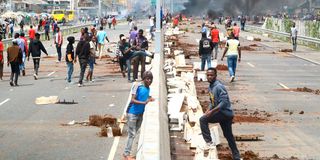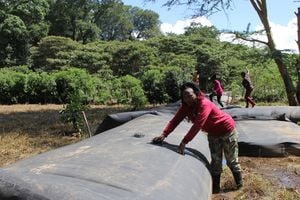Violent demos chipping away at Kenya’s democratic gains

Demonstrators engage in looting and destruction of properties of the Expressway along Mombasa Road at Mlolongo on July 12, 2023, during the anti-government protest.
Kenya is hurting after waves of deadly protests and disruptions over the cost of living, taxes and alleged stolen election. What started on January 23, 2023 as a low-key ‘consultative forum’ by the opposition over last year’s election results has morphed into frequent anti-government violent demonstrations.
Strangely, Nairobi is not buying the line that the country is hurtling down to failure. Its foreign policy wonks are swearing with all the oracles that the opposition-led protests have no impact on either Kenya’s economy at home or image abroad.
On July 14, 2023, the office of the United Nations High Commissioner on Human Rights (OHCHR) reported that 23 people had been killed and dozens injured in the recent wave of anti-government riots. This stoked the ire of Kenya’s foreign policy pundits, who accused the international community of meddling in the country’s internal affairs, undermining its sovereignty and inflating the demonstration death count.
Truth be told, the protests have exacted a heavy toll on Kenya’s economy and brand. For long considered one of Africa's most stable and prosperous economies, the protests risk pushing Kenya deeper into a dark and dangerous cesspit of violence. Regionally and abroad, Kenya’s image is that of a country on fire, a failing hegemon rapidly losing an opportunity for regional leadership.
Largest economy
As of 2020, Kenya had the third largest economy in Sub-Saharan Africa, after Nigeria and South Africa, and East Africa’s largest economy. Protracted deadly protests put this economy at dire risk.
Protests are the newest assault on Kenya’s struggling economy, which is yet to recover from the impacts of desert locust invasion, the longest and severest drought in the region for decades, the Covid-19 pandemic and the War in Ukraine.
Riots have paralysed and shut down business in parts of the country, destroyed property and exacted a heavy toll on the economy. Demonstrations have disrupted economic activity, slowed down economic growth and development and reduced productivity and output.
By July 24, Kenya was losing an estimated Sh3 billion ($20 million) a day due to the protests and disruptions, according to both the Kenya Association of Manufacturers and the Kenya Private Sector Alliance (Kepsa).
Postponing investments
Perceiving the country as high-risk, investors are suspending trips to Kenya and postponing investments fearing being caught up in the chaos, reducing the flow of foreign investments when the country badly need new investments.
Local and foreign investors are taking their investments elsewhere, thereby reducing cash in circulation. In May and June, Tanzania — and Uganda and Rwanda, too — has seen an influx of investors due to the perception that Kenya is on fire.
Also hit hard by the riots is tourism, which accounts for approximately 10 per cent of Kenya’s GDP and employs over 1.5 million people.
Travel advisories issued by some of Kenya’s foreign partners have led to decline in tourist arrivals. The Kenya Association of Hotelkeepers and Caterers has warned that Kenya, increasingly seen as an unsafe tourist destination, risks losing a whole year of tourism as a result of protests.
Disruptions of the transport sector have reduced movement of goods, people and services, literally crippling the economy. On July 19, the Kenya Railways Corporation, whose passenger trains have been targeted for vandalism, suspended rail services in the Nairobi area due to the planned anti-government protests. Moreover, on July 13, the Expressway at Mlolongo was vandalised, disrupting any movement along the road for two days. It will cost the country Sh700 million to repair the expressway, according to the Ministry of Transport chiefs.
In recent weeks, the Mombasa port has been losing business destined for Uganda, Rwanda, Burundi and the Democratic Republic of Congo to the port of Dar es Salaam. Notably, Uganda is Kenya’s biggest trading partner, which receives Kenya exports worth US$800 million annually.
Kenya’s agricultural sector, the mainstay of the economy which engages approximately 75 per cent of the population, has not been spared by the mayhem. Protests have disrupted supply chains, reduced agricultural production, causing food shortages and an increase in food prices.
Continued protests over extended periods have undermined business confidence, led to the closure of manufacturing firms in urban areas affected by riots and job losses.
The protests are aggravating Kenya’s debt repayment problem at a time when the sovereign debt is already causing concerns. The country’s $2 billion Eurobond is maturing in June 2024 and the country’s total external debt, which stood at $34.8 billion in 2020 (35.4% of GDP), is increasing.
Sovereign default
For three years straight, the Kenyan shilling has been on a free-fall with little sign of recovery. The rapid depreciation of the Kenyan shilling has raised concerns about the potential for a sovereign default.
The Kenya Revenue Authority (KRA) has missed its monthly revenue targets for February and March following the January-March protests. Recent tax hikes, including on fuel, motorcycles and cooking gas, have increased the economic burden for many Kenyans. As a result, the government delayed payments for civil servants in March.
The riots have also rocked financial markets, including disruption of financial transactions, closure of financial institutions, decline in investor confidence and shrinking stock market.
The riots are paralysing the education system. The Kenya Secondary School Heads Association (KSSHA) has stated that anti-government protests have disrupted learning in schools, with students at all levels losing between 14 and 20 hours of teaching and learning. This will adversely affect the school calendar.
Also affected is the healthcare sector, which has experienced disruption and reduced access to healthcare services, potentially contributing to higher morbidity and mortality rates.
Foreign policy officers have cause to fret over the erosion of Kenya’s sovereignty by riots. A deadly wave of political violence after the elections in 2007 and 2017, where 1,200 and 100 people were killed respectively, saw the intervention by external actors, including the Hague-based International Criminal Court (ICC). As a result of the controversial death counts, fingers are being pointed to the government for “high levels of violence, including the use of live rounds and the destruction of property”. And the international community will always assert its moral responsibility to protect.
Protracted protests are inevitably chipping Kenya’s democracy, resulting in a serious democratic recession. Kenya badly needs elite consensus to address harsh economic times, slowed economic growth and potential of state failure.
Sadly, Kenya’s power elite is digging in. The country needs a council of eminent Kenyans to mediate the crisis and create chances for an amicable end to the protests.
Prof Kagwanja is a former Government Adviser and Chief Executive of Africa Policy Institute.





